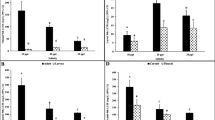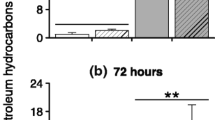Abstract
Encapsulated embryos and free-living larvae of Ilyanassa obsoleta were exposed to concentrations of No. 2 fuel oil (water-accommodated fraction, WAF) up to 1.0 ppm. Development of velum pigmentation and release of larvae from egg capsules were delayed in the presence of 1.0 ppm WAF, but exposure to the oil did not increase developmental mortality of encapsulated individuals. Individuals which were prematurely removed from egg capsules and exposed to oil directly suffered no mortality until yolk reserves were depleted and feeding on phytoplankton commenced. Feeding, free-living larvae suffer high mortality at 1.0 ppm WAF. The reduced susceptibility of encapsulated embryos to the oil stress may therefore reflect the importance of toxicant uptake by ingestion (as opposed to diffusion) rather than the degree of protection afforded by encapsulation.
Access this article
We’re sorry, something doesn't seem to be working properly.
Please try refreshing the page. If that doesn't work, please contact support so we can address the problem.
Similar content being viewed by others
Literature Cited
Anderson, J. W., J. M. Neff, B. A. Cox, H. E. Tatum, and G. M. Hightower. 1974. Characteristics of dispersions and water-soluble extracts of crude and refined oils and their toxicity on estuarine crustaceans and fish. Mar. Biol. 27:75–88.
Anderson, J. W., D. B. Dixit, G. S. Ward, and R. S. Foster. 1977. Effects of petroleum hydrocarbons on the rate of heart beat and hatching success of estuarine fish embryos, p. 241–258. In F. J. Vernberg, A. Calabrese, F. P. Thurberg, and W. B. Vernberg (eds.), Physiological Responses of Marine Biota to Pollutants. Academic Press, New York.
Bigford, T. E. 1977. Effects of oil on behavioral response to light, pressure, and gravity in larvae of the Rock Crab Cancer irroratus. Mar. Biol. 43:137–148.
Boehm, P. D., and J. G. Quinn. 1974. The solubility behavior of No. 2 fuel oil in sea water. Mar. Poll. Bull. 5:101–105.
Boehm, P. D., and J. G. Quinn. 1976. The effect of dissolved organic matter in sea water on the uptake of mixed individual hydrocarbons and number 2 fuel oil by a marine filter-feeding bivalve (Mercenaria mercenaria). Estuarine Coastal Mar. Sci. 4:93–105.
Byrne, C. J., and J. A. Calder. 1977. Effect of the water-soluble fractions of crude, refined, and waste oils on the embryonic and larval stages of the quahog clam Mercenaria sp. Mar. Biol. 40:225–231.
Corner, E. D. S., and R. P. Harris. 1976. Hydrocarbons in marine zooplankton and fish. Part I. Zooplankton, p. 71–85. In A. P. M. Lockwood. (ed.), Effects of Pollutants on Aquatic Organisms. Cambridge University Press, Cambridge, England.
Dobroski, C. J., Jr., and C. E. Epifanio. 1980. Accumulation of a benzo[α]-pyrene in a larval bivalve via trophic transfer. Can J. Fish. Aquat. Sci. 37: 2318–2322.
Ernst, V. V., J. M. Neff, and J. W. Anderson. 1977. The effects of the water-soluble fractions of No. 2 fuel oil on the early development of the estuarine fish, Fundulus grandis Baird and Girard. Environ. Poll. 14:25–35.
Fretter, V., and M. C. Montgomery. 1968. The treatment of food by prosobranch veligers. J. Mar. Biol. Assoc. U.K. 48:499–520.
Giese, A. C., and J. S. Pearse. 1974. Reproduction of marine invertebrates. Vol. 1: Acoelomate and pseudocoelomate metazoans. Academic Press, New York. 546 p.
Holland, D. L., R. Tantanasiriwong, and P. J. Hannant. 1975. Biochemical composition and energy reserves in the larvae and adults of the four British periwinkles Littorina littorea, L. littoralis, L. saxatilus, and L. neritoides. Mar. Biol. 33:235–239.
Hyland, J. L., P. F. Rogerson, and G. R. Gardner. 1977. A continuous flow bioassay system for the exposure of marine organisms to oil, p. 547–550. In Proc. 1977 Oil Spill Conference, American Petroleum Institute.
Johns, D. M., and J. A. Pechenik. 1980. Influence of the water-accommodated fraction of No. 2 fuel oil on energetics of Cancer irroratus larvae. Mar. Biol. 55:247–254.
Klumpp, D. W. 1980. Accumulation of arsenic from water and food by Littorina littoralis and Nucella lapillus. Mar. Biol. 58:265–274.
Laughlin, R. B., Jr., L. G. L. Young, and J. M. Neff. 1978. A long-term study of the effects of waters-soluble fractions of No. 2 fuel oil on the survival, development rate, and growth of the mud crab Rhithropanopeus harrisii. Mar. Biol. 47:87–95.
McKim, J. M. 1977. Evaluation of tests with early life stages of fish for predicting long-term toxicity. J. Fish Res. Board Can. 34:1148–1154.
Moore, S. F., and R. L. Dwyer. 1974. Effects of oil on marine organisms: a critical assessment of published data. Water Res. 8:819–827.
Pandian, T. J. 1969. Yolk utilization in the gastropod Crepidula fornicata. Mar. Biol. 3:117–121.
Pechenik, J. A. 1975. The escape of veligers from the egg capsules of Nassarius obsoletus and Nassarius trivittatus (Gastropoda, Prosobranchia). Biol. Bull. 149:580–589.
Pechenik, J. A. 1978. Adaptations to intertidal development: studies on Nassarius obsoletus. Biol. Bull. 154:282–291.
Pechenik, J. A. 1982. Ability of some gastropod egg capsules to protect against low-salinity stress. J. Exp. Mar. Biol. Ecol. 63:195–208.
Pechenik, J. A., and N. S. Fisher. 1979. Feeding, assimilation, and growth of mud snail larvae, Nassarius obsoletus (Say), on three different algal diets. J. Exp. Mar. Biol. Ecol. 37:57–80.
Pechenik, J. A., D. M. Johns, and D. C. Miller. 1979. Influence of No. 2 fuel oil on survival and reproduction of four marine invertebrates, p. 135–156. In F. Jackoff (ed.), Proc. Symp. The State of Marine Environmental Research. EPA-600/9-79-035, USEPA, Narragansett, R.I.
Rosenberg, R., and J. D. Costlow, Jr. 1976. Synergistic effects of cadmium and salinity combined with constant and cycling temperatures on the larval development of two estuarine crab species. Mar. Biol. 38:291–303.
Rossi, S. S., and J. W. Anderson. 1976. Toxicity of water soluble fractions of No. 2 fuel oil and South Louisiana Crude Oil to selected stages in the life history of polychaete, Neanthes arenaceodentata. Bull. Environ. Contam. Toxicol. 16:18–24.
Scheltema, R. S. 1962. Pelagic larvae of New England intertidal gastropods: I. Nassarius obsoletus (Say) and Nassarius vibex (Say). Trans. Am. Microsc. Soc. 81:1–11.
Scheltema, R. S. 1964. Feeding habits and growth in the mud-snail Nassarius obsoletus. Chesapeake Sci. 5:161–166.
Young, M. L. 1977. The roles of food and direct uptake from water in the accumulation of zinc and iron in the tissues of the dogwhelk, Nucella lapillus (L.). J. Exp. Mar. Biol. Ecol. 30:315–325.
Author information
Authors and Affiliations
Additional information
Contribution No. 240 from the Environmental Research Laboratory, U.S.E.P.A., Narragansett, RI.
Rights and permissions
About this article
Cite this article
Pechenik, J.A., Miller, D.C. Increased susceptibility to No. 2 fuel oil coincident with initiation of particle feeding in developing mud snails, Ilyanassa obsoleta . Estuaries 6, 237–242 (1983). https://doi.org/10.2307/1351515
Received:
Accepted:
Issue Date:
DOI: https://doi.org/10.2307/1351515




